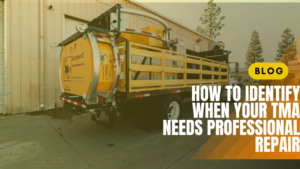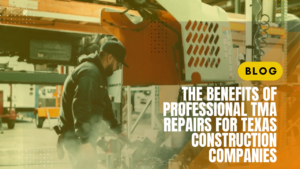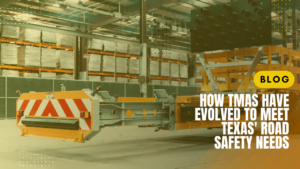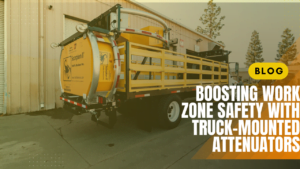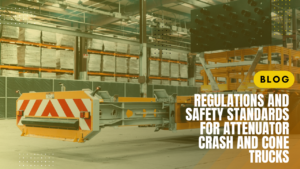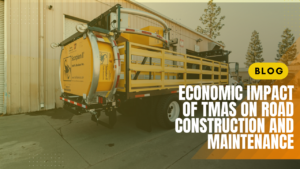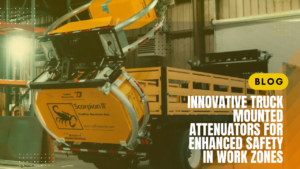Road safety in construction zones is a big worry for everyone. A Truck Mounted Attenuator (TMA) is designed to save lives by absorbing crash impacts. This guide dives into what TMAs are, why they’re crucial, and how they work to protect both drivers and workers.
Keep reading; it gets interesting!
What is a TMA Truck?
A TMA truck, also known as a Truck Mounted Attenuator, is a specialized vehicle used in highway work zones for protecting workers and motorists. It serves as a mobile barrier designed to absorb the impact of vehicles and increase safety in construction areas.
Other names for TMAs
Truck Mounted Attenuators, often called TMAs, go by several other names in the industry. People sometimes refer to them as crash cushions or impact attenuators because of their role in absorbing the energy from vehicle impacts.
This function makes them crucial for driver and worker safety in highway work zones.
In some circles, they are also known as shadow vehicles. They serve as mobile barriers that shield workers and equipment from oncoming traffic. By operating under these various names, TMAs play a vital role in traffic control and road construction safety, ensuring protection for both drivers and road crews.
Common uses
While TMAs are known by various names, their primary function shines through in several key applications. One of the most significant uses of truck-mounted attenuators is in highway work zones, where they serve as a first line of defense for both workers and drivers.
By absorbing the impact from wayward vehicles, these devices prevent accidents from escalating, ensuring safety within road construction sites. This protection is crucial not just for human life but also for minimizing damage to construction equipment and ongoing projects.
In addition to work zone safety, TMAs play a vital role as shadow vehicles during mobile operations like painting road markings or repairing street lights. They create a safe barrier around moving work crews, enhancing visibility with warning lights and chevron markings.
These applications underscore the importance of TMAs in maintaining smooth traffic flow and preventing disruptions during essential road maintenance activities. Such versatile use demonstrates how integral truck-mounted attenuators are to modern transportation engineering efforts aimed at improving overall traffic safety and driver security on highways and city streets alike.
Purpose and necessity
Truck Mounted Attenuators (TMAs) serve a crucial role in enhancing traffic safety in highway work zones. They act as mobile barriers, designed to absorb the impact of a vehicle crash, thereby protecting both drivers and work crews.
This capacity to mitigate collision effects dramatically reduces potential injuries and fatalities on the road.
The necessity for TMAs stems from their proven effectiveness in safeguarding lives. Studies show that incorporating these energy-absorbing devices into work zone setups significantly lowers risks associated with crashes.
Furthermore, guidelines such as MASH recommend evaluating and crash testing TMAs to ensure they meet safety standards, underscoring their importance in highway construction and maintenance projects.
Next, we explore how TMAs operate and who benefits from their protection.
How it works and who it protects
Truck mounted attenuators (TMAs) are designed to absorb the impact of a wayward vehicle, protecting both work crews and passing drivers in construction zones. TMAs work by providing a cushioned barrier on the rear of a shadow vehicle or an attenuator truck which acts as a mobile solution for minimizing collision impacts in traffic control.
By absorbing kinetic energy during an impact, TMAs significantly reduce the risk of severe injury or even fatalities that may occur when vehicles enter work zones. This makes them crucial safety features for highway work zones, ensuring driver safety and mitigating potential hazards in areas with ongoing road construction.
Constructed to protect against collisions occurring within work zones, TMAs serve as vital traffic safety devices that support visibility enhancement and shield workers from the dangers posed by passing vehicles.
When Is a TMA Required in Work Zones?

TMA is required in work zones when the speed limit exceeds 45 mph and workers are within the active construction area, ensuring safety for both workers and passing vehicles. For more on TMA requirements, continue reading below.
Guidelines and regulations
Guidelines and regulations for truck mounted attenuators (TMAs) encompass various aspects, including industry standards, safety measures, and deployment protocols. The Manual for Assessing Safety Hardware (MASH) provides guidelines for evaluating the crashworthiness of TMAs through rigorous testing procedures.
These regulations ensure that TMAs meet specific impact resistance criteria to safeguard both workers and motorists in highway work zones. Additionally, cost-effective rental options are available for temporary TMA installation, aligning with traffic control budgetary considerations.
Safety measures associated with TMA usage include visibility enhancement through chevron markings and warning lights on shadow vehicles. These enhancements aim to mitigate collision risks by increasing driver awareness of work zone conditions.
Factors that determine TMA usage
Factors that determine TMA usage:
- Traffic volume and speed in the work zone significantly impact the need for a TMA truck.
- The presence of heavy machinery and work crews near the roadway necessitates the use of a TMA for added protection.
- The type and duration of the road construction project influence whether a TMA is necessary.
- Statutory regulations and guidelines regarding work zone safety play a crucial role in determining TMA usage.
- The assessment of crash history and incident data informs the decision to deploy a TMA in specific work zones.
- Weather conditions, such as visibility and precipitation, are taken into account when evaluating the need for a TMA truck.
- The potential risk posed by passing traffic and proximity to intersecting roadways is considered in deciding on TMA deployment.
Components and Features of a TMA
Truck Mounted Attenuators (TMAs) consist of various types of attenuators that are designed to absorb the impact energy and protect road workers and other drivers from collisions in work zones.
To learn more about the different components and features, delve into our comprehensive guide.
Types of attenuators
Truck mounted attenuators (TMAs) come in various types, each designed to absorb impact and protect drivers and workers in construction zones. Understanding the different types of attenuators is crucial for ensuring the safety of road construction projects:
- Water-filled attenuators: These systems consist of plastic barrels filled with water, effectively absorbing impact energy during a collision.
- Crushable concrete attenuators: These attenuators are made from crushable materials such as concrete or foam, providing a sturdy barrier that absorbs impact forces.
- Steel-encased attenuators: These attenuators are constructed with steel casing to provide strong protection and absorb collision energy efficiently.
- Non-energy-absorbing guardrail end treatments: These systems are designed to prevent snagging and reduce vehicle intrusion, enhancing overall crash safety at the end of roadside barriers.
Traffic control devices to reduce TMA crashes
To reduce TMA crashes, traffic control devices play a crucial role in ensuring the safety of work zones and minimizing the risk of collisions. These devices include:
- Impact Attenuators: These are energy-absorbing devices that are strategically placed to minimize the impact force of vehicles approaching work zones, providing a protective cushion.
- Shadow Vehicles: These vehicles are equipped with high-visibility lighting and markings, serving as a visible warning to approaching drivers and effectively creating a buffer zone around the work area.
- Warning Lights and Chevron Markings: The use of highly visible warning lights and chevron markings on vehicles and barriers enhances their visibility, alerting drivers to the presence of potential hazards.
- Mobile Barriers: Strategically positioned mobile barriers act as temporary protective shields, directing traffic away from work areas while absorbing impact forces in case of collisions.
- Visibility Enhancement: Implementing innovative technologies such as intelligent transport systems aids in enhancing the visibility and awareness of both drivers and work crews within the work zone.
- Barrier Protection: The implementation of robust barrier systems provides an additional layer of protection by effectively separating traffic from construction activities, reducing the likelihood of TMA-related incidents.
Warning lights and chevron markings
Warning lights and chevron markings are essential components of truck-mounted attenuators (TMAs). These features enhance visibility for approaching drivers, alerting them to the presence of a work zone and promoting safety.
The warning lights, often positioned on the TMA truck itself, along with the distinctive chevron markings on the rear of the vehicle, play a crucial role in increasing awareness and reducing the risk of collisions in highway work zones.
By providing optimal visibility and clear directional indicators to drivers, these elements contribute to overall traffic safety by minimizing potential hazards associated with construction activities.
Incorporating dynamic warning lights and conspicuous chevron markings as part of TMAs aligns with guidelines aimed at improving road safety. These visual enhancements support better recognition and response from motorists navigating through work zones by effectively signaling lane configurations, merging points, or changes in traffic patterns.
Work zone conditions and configurations
Work zone conditions and configurations must be carefully assessed to ensure the effective placement of TMAs. Factors such as road layout, traffic flow, and work crew positioning are crucial in determining where truck-mounted attenuators should be stationed.
Proper visibility, adequate space for vehicle maneuvering, and clear signage play key roles in optimizing TMA functionality within work zones. Additionally, ongoing assessment and adjustment of these configurations as work progresses are essential for maintaining optimal safety measures.
The configuration of work zones can impact the effectiveness of TMAs in mitigating collision impacts. It is important to consider factors such as lane width, traffic speed limits, and potential blind spots when positioning truck-mounted attenuators within work zones.
Training and use of intelligent transport systems
Truck drivers receive training on the proper use of intelligent transport systems (ITS) to enhance their interaction with TMAs. These technologies include GPS, radar, and cameras that help monitor traffic patterns and vehicle behavior in work zones.
The use of ITS enables real-time data collection, aiding in the analysis of TMA performance and effectiveness. Additionally, training programs emphasize the importance of integrating these systems into TMA operations to optimize safety measures for both drivers and road construction crews.
Moreover, intelligent transport systems play a crucial role in enhancing TMA visibility through warning lights and chevron markings. This allows for timely responses by shadow vehicles equipped with advanced communication tools connected to ITS.
The Future of TMAs and Autonomous Mobility
Technological advancements are shaping the future of TMAs, integrating autonomous vehicles and potential benefits while addressing challenges. To learn more about the exciting developments in TMA technology and how they relate to autonomous mobility, dive into the full article.
Advancements in TMA technology
Advancements in TMA technology have led to the development of enhanced crash cushion designs, maximizing energy absorption capabilities to better protect both road workers and motorists.
These improved attenuators undergo rigorous testing, following guidelines from organizations such as MASH, ensuring their effectiveness in reducing the impact of collisions. The integration of advanced materials and engineering techniques has also contributed to making TMAs more durable and reliable, enhancing overall work zone safety.
Innovative advancements in TMA technology are paving the way for increased visibility and warning systems, including dynamic lighting and signaling features. These improvements aim to alert drivers effectively about approaching work zones while providing clear guidance on navigating around them.
Integration of autonomous vehicles and TMAs
Autonomous vehicles are being integrated with truck-mounted attenuators (TMAs) to enhance work zone safety further. This integration aims to improve traffic control and driver safety in highway work zones by leveraging the advanced technology of autonomous mobility.
The potential benefits include enhanced efficiency, reduced human error, and improved overall traffic flow in construction areas due to seamless coordination between TMAs and autonomous vehicles.
However, challenges such as adapting regulations and ensuring compatibility with existing infrastructure need careful consideration before full-scale implementation.
Potential benefits and challenges
Truck Mounted Attenuators (TMAs) offer various benefits, including enhanced road safety by absorbing impact during collisions in work zones. They protect both drivers and construction workers from potential harm and reduce the severity of accidents.
TMAs also provide visibility enhancement, making it easier for motorists to navigate through construction areas while ensuring barrier protection. Moreover, their mobile nature allows for flexibility in deployment, aiding in quick setup and removal as needed.
However, challenges related to TMAs include cost implications for acquisition and rental, adherence to stringent safety measures, and ongoing maintenance requirements. Additionally, integrating new TMA designs while complying with guidelines necessitates thorough evaluation and crash testing.
Conclusion
Understanding Truck Mounted Attenuators (TMAs) promotes safer work zones and highways. TMA technology continues to advance, integrating with autonomous vehicles for improved protection.
Industry recognition underscores the significance of TMAs in enhancing traffic safety. Complying with guidelines and regulations ensures effective utilization of TMAs in construction areas.
Training on TMA installation and removal fosters efficient implementation for road construction projects.
FAQs
1. What is a Truck Mounted Attenuator (TMA)?
A TMA is a device attached to the rear of a vehicle to absorb impact energy and reduce damage in case of a collision.
2. How does a Truck Mounted Attenuator (TMA) improve safety?
TMAs enhance safety by providing cushioning during rear-end collisions, protecting both the vehicle occupants and workers in construction zones.
3. Are there different types of Truck Mounted Attenuators (TMAs)?
Yes, TMAs come in various designs and sizes to accommodate different vehicles and road work requirements.
4. What are the maintenance requirements for Truck Mounted Attenuators (TMAs)?
Regular inspections for any signs of wear or damage, as well as following manufacturer guidelines for upkeep, are essential for maintaining TMAs.
5. Can TMAs be installed on all types of vehicles?
While TMAs can be installed on many vehicles such as trucks and trailers, it’s important to ensure compatibility with specific vehicle models before installation.
For TMAs, contact us here


